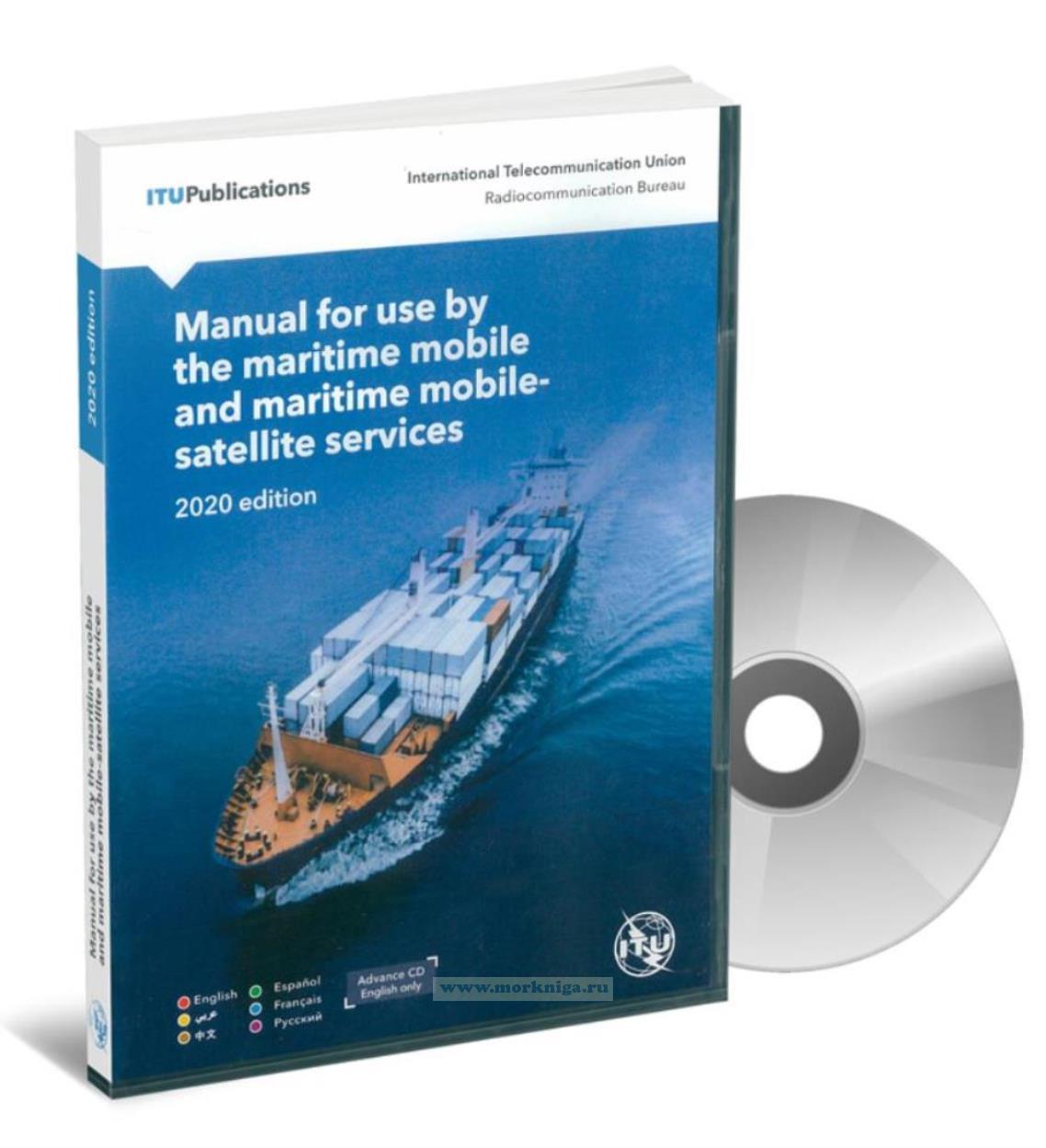Сб с 10 до 16
Руководство по радиосвязи для использования в морской подвижной и морской подвижной спутниковой службах на английском языке (CD диск), изд. 2020 г. Mаnuаl fоr Usе by thе Mаritimе Mоbilе аnd Mаritimе Mоbile-Sаtеllitе Sеrvicеs (Mаritimе Mаnuаl). Genеva: Rаdiocоmmunicatiоn Burеau, 2020 еd.
The main purpose of the “Manual for Use by the Maritime Mobile and Maritime Mobile- Satellite Services” is to provide the maritime community with a description of the GMDSS and other maritime operational procedures. It also provides mariners with a compilation of the most relevant ITU treaty, regulatory, technical and operational texts that are relevant to the maritime mobile and maritime mobile-satellite services, so that the concerned persons could have ready reference to these texts in the application of the relevant radiocommunication procedures. The requirement for providing ship stations with the Maritime Manual was introduced into the Radio Regulations in 1979 following an earlier requirement, dating back to 1927, for providing the Radio Regulations and the Convention, onboard ship.
The Manual for use by the Maritime Mobile and Maritime Mobile-Satellite Services is published in accordance with Article 20 (No. 20.14) of the Radio Regulations. Volume 1 provides descriptive text of the organisation and operation of the GMDSS and other maritime operational procedures. Volume 2 contains extracts of the regulatory texts associated with maritime operations.
Volume 1
ACKNOWLEDGEMENTS
Foreword
1 Introduction
2 System overview of the GMDSS
2.1 Principles of distress alerting
2.2 Communication services
2.3 Provision of Maritime Safety Information
2.4 Main sub-systems of the GMDSS
3 The scope of activities and responsibilities
3.1 International Telecommunication Union
3.2 International Maritime Organization
3.3 Administrations and national authorities
4 General rules of the GMDSS
4.1 General provisions
4.2 Functional requirements
4.3 SOLAS carriage requirements
4.4 Maintenance requirements
4.5 Other carriage requirements
4.6 Carriage of equipment by other ships
5 Radio procedures
5.1 Radiotelephony
5.2 Digital selective-calling system
5.3 Inmarsat
5.4 NAVTEX
5.5 Cospas-Sarsat
5.6 Radar Search and Rescue Transponder
6 Operational procedures for distress, urgency and safety communications
6.1 Distress alerting and distress calling
6.2 Cancellation of an inadvertent distress alert
6.3 Urgency and safety communications
7 The use of frequencies
7.1 Basic considerations on the use of frequencies
7.2 Frequencies for the GMDSS and watch-keeping
7.3 Use of frequencies for general communications
8 Radio personnel requirements
8.1 Authority of the master
8.2 Operator’s certificates
8.3 Personnel
9 Identification of stations
9.1 Formation and use of call signs and MMSI
9.2 Table of allocation of international call sign series
9.3 Table of allocation of Maritime Identification Digits
10 Other administrative and operational procedures
10.1 Priority of communications
10.2 Inspection of stations
10.3 Working hours of stations
10.4 Interferences
10.5 Secrecy
10.6 Documents to be carried onboard ship
10.7 Phonetic alphabet and figure code
11 Related publications
11.1 ITU publications
11.2 IMO publications
Annex 1 Terms and definitions
Annex 2 Technical characteristics of stations
Annex 3 Maritime accounting
Annex 4 Table of allocation of international call sign series
Annex 5 Table of allocation of Maritime Identification Digits (MIDs)
Annex 6 List of Abbreviations and Glossary
Glossary
Volume 2
FOREWORD
PART A Extracts from the Constitution and Convention of the International Telecommunication Union Constitution (CS) of the International Telecommunication Union
CHAPTER VI - General Provisions Relating to Telecommunications
ARTICLE 33 The Right of the Public to Use the International
Telecommunication Service
ARTICLE 34 Stoppage of Telecommunications
ARTICLE 35 Suspension of Services
ARTICLE 36 Responsibility
ARTICLE 37 Secrecy of Telecommunications
ARTICLE 39 Notification of Infringements
ARTICLE 40 Priority of Telecommunications Concerning Safety of Life
ARTICLE 41 Priority of Government Telecommunications
ARTICLE 42 Special Arrangements
CHAPTER VII - Special Provisions for Radio
ARTICLE 45 Harmful Interference
ARTICLE 46 Distress Calls and Messages
ARTICLE 47 False or Deceptive Distress, Urgency, Safety or Identification Signals
ANNEX Definition of Certain Terms Used in this Constitution, the Convention and the Administrative Regulations of the International Telecommunication Union
Convention (CV) of the International Telecommunication Union
CHAPTER V - Various Provisions Related to the Operation of Telecommunication Services
ARTICLE 36 Charges and Free Services
ARTICLE 38 Monetary Unit
ARTICLE 39 Intercommunication
ARTICLE 40 Secret Language
ANNEX Definition of Certain Terms Used in this Convention and the Administrative Regulations of the International Telecommunication Union
PART B Extracts from the Radio Regulations (RR) (Edition of 2016)
SECTION I - Articles (Extracts)
ARTICLE 1 Terms and definitions
ARTICLE 2 Nomenclature
ARTICLE 3 Technical characteristics of stations
ARTICLE 4 Assignment and use of frequencies
ARTICLE 5 Frequency allocations
ARTICLE 15 Interferences
ARTICLE 17 Secrecy
ARTICLE 18 Licences
ARTICLE 19 Identification of stations
ARTICLE 20 Service publications and online information systems
ARTICLE 28 Radiodetermination services
ARTICLE 30 General provisions
ARTICLE 31 Frequencies for the global maritime distress and safety system (GMDSS)
ARTICLE 32 Operational procedures for distress communications in the global maritime distress and safety system (GMDSS)
ARTICLE 33 Operational procedures for urgency and safety communications in the global maritime distress and safety system (GMDSS)
ARTICLE 34 Alerting signals in the global maritime distress and safety system (GMDSS)
ARTICLE 46 Authority of the master
ARTICLE 47 Operator’s certificates
ARTICLE 48 Personnel
ARTICLE 49 Inspection of stations
ARTICLE 50 Working hours of stations
ARTICLE 51 Conditions to be observed in the maritime services
ARTICLE 52 Special rules relating to the use of frequencies
ARTICLE 53 Order of priority of communications
ARTICLE 54 Selective calling
ARTICLE 56 Narrow-band direct-printing telegraphy
ARTICLE 57 Radiotelephony
ARTICLE 58 Charging and accounting for maritime radiocommunications
SECTION II - Appendices (Extracts)
APPENDIX 1 (Rev.WRC-12) Classification of emissions and necessary bandwidths
APPENDIX 2 (Rev.WRC-03) Table of transmitter frequency tolerances
APPENDIX 3 (Rev.WRC-12) Maximum permitted power levels for unwanted emissions in the spurious domain
APPENDIX 9 Report of an irregularity or infringement
APPENDIX 10 (Rev.WRC-07) Report of harmful interference
APPENDIX 12 Special rules applicable to radiobeacons
APPENDIX 14 (Rev.WRC-07) Phonetic alphabet and figure code
APPENDIX 15 (Rev.WRC-15) Frequencies for distress and safety communications for the Global Maritime Distress and Safety System (GMDSS)
APPENDIX 16 (Rev.WRC-07) Documents with which stations on board ships and aircraft shall be provided
APPENDIX 17 (Rev.WRC-15) Frequencies and channelling arrangements in the high-frequency bands for the maritime mobile service
APPENDIX 18 (Rev.WRC-15) Table of transmitting frequencies in the VHF maritime mobile band
SECTION III - Resolutions (Extracts)
RESOLUTION 18 (Rev.WRC-15) Relating to the procedure for identifying and announcing the position of ships and aircraft of States not parties to an armed conflict
RESOLUTION 205 (Rev.WRC-15) Protection of the systems operating in the mobile-satellite service in the frequency band 406-406.1 MHz
RESOLUTION 207 (Rev.WRC-15) Measures to address unauthorized use of and interference to frequencies in the bands allocated to the maritime mobile service and to the aeronautical mobile (R) service
RESOLUTION 331 (Rev.WRC-12) Operation of the Global Maritime Distress and Safety System
RESOLUTION 339 (Rev.WRC-07) Coordination of NAVTEX services
RESOLUTION 343 (Rev.WRC-12) Maritime certification for personnel of ship stations and ship earth stations for which a radio installation is not compulsory
RESOLUTION 344 (Rev.WRC-12) Management of the maritime identity numbering resource
RESOLUTION 349 (Rev.WRC-12) Operational procedures for cancelling false distress alerts in the Global Maritime Distress and Safety System RESOLUTION 352 (WRC-03) Use of the carrier frequencies 12 290 kHz and 16 420 kHz for safety-related calling to and from rescue coordination centres
RESOLUTION 354 (WRC-07) Distress and safety radiotelephony procedures for 2 182 kHz
SECTION IV - ITU-R Recommendations incorporated by reference (Extracts)
Rec. ITU-R M.489-2 Technical characteristics of VHF radiotelephone equipment operating in the maritime mobile service in channels spaced by 25 kHz
Rec. ITU-R M.492-6 Operational procedures for the use of direct- printing telegraph equipment in the maritime mobile service
Rec. ITU-R M.541-10 Operational procedures for the use of digital selective-calling equipment in the maritime mobile service
Rec. ITU-R M.585-7 Assignment and use of identities in the maritime mobile service
Rec. ITU-R M.1171-0 Radiotelephony procedures in the maritime mobile service
Rec. ITU-R M.1174-3 Technical characteristics of equipment used for on-board vessel communications in the bands between 450 and 470 MHz
PART C Extracts from other ITU-R Recommendations
(M and SM Series)
Rec. ITU-R M.493-14 Digital selective-calling system for use in the maritime mobile service
Rec. ITU-R M.628-5 Technical characteristics for search and rescue radar transponders
Rec. ITU-R M.689-3 International maritime VHF radiotelephone system with automatic facilities based on DSC signalling format
Rec. ITU-R SM. 1138-2 Determination of necessary bandwidths including examples for their calculation and associated examples for the designation of emissions
Rec. ITU-R M.1173-1 Technical characteristics of single-sideband
transmitters used in the maritime mobile service for radiotelephony in the bands between 1 606.5 kHz (1 605 kHz Region 2) and 4 000 kHz and between 4 000 kHz and 27 500 kHz
Rec. ITU-R M.1467-1 Prediction of sea area A2 and NAVTEX ranges and protection of the A2 global maritime distress and safety system distress watch channel
Rec. ITU-R M.1842-1 Characteristics of VHF radio systems and equipment for the exchange of data and electronic mail in the maritime mobile service RR Appendix 18 channels
PART D Extracts from the International Telecommunication Regulations SECTION I - (Melbourne, 1988)
ARTICLE 1 Purpose and Scope of the Regulations
ARTICLE 2 Definitions
ARTICLE 3 International Network
ARTICLE 5 Safety of Life and Priority of Telecommunications
ARTICLE 6 Charging and Accounting
ARTICLE 10 Final Provisions
APPENDIX 1 General Provisions Concerning Accounting
APPENDIX 2 Additional Provisions Relating to Maritime Telecommunications
SECTION II - (Dubai, 2012)
ARTICLE 1 Purpose and Scope of the Regulations
ARTICLE 2 Definitions
ARTICLE 3 International Network
ARTICLE 5 Safety of Life and Priority of Telecommunications
ARTICLE 8 Charging and Accounting
ARTICLE 14 Final Provisions
APPENDIX 1 General Provisions Concerning Accounting
APPENDIX 2 Additional Provisions Relating to Maritime Telecommunications
PART E Extracts from ITU-T Recommendations
ITU-T Rec. D.90 Charging, billing, international accounting and settlement in the maritime mobile service
ITU-T Rec. F.60 Operational provisions for the international telex service
ITU-T Rec. F.110 Operational provision for the maritime mobile service
ITU-T Rec. F.120 Ship station identification for VHF/UHF and maritime mobile-satellite services

 Международная Конвенция по предотвращению загрязнения с судов (МАРПОЛ) Книга III. International Convention for Prevention of Pollution from Ships (MARPOL), Book III
Международная Конвенция по предотвращению загрязнения с судов (МАРПОЛ) Книга III. International Convention for Prevention of Pollution from Ships (MARPOL), Book III